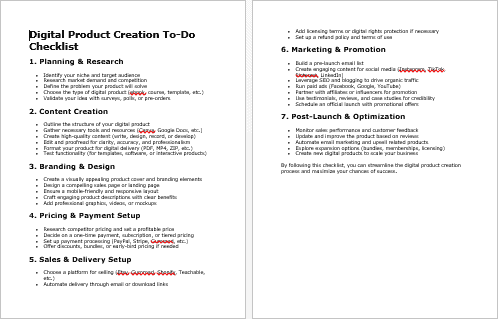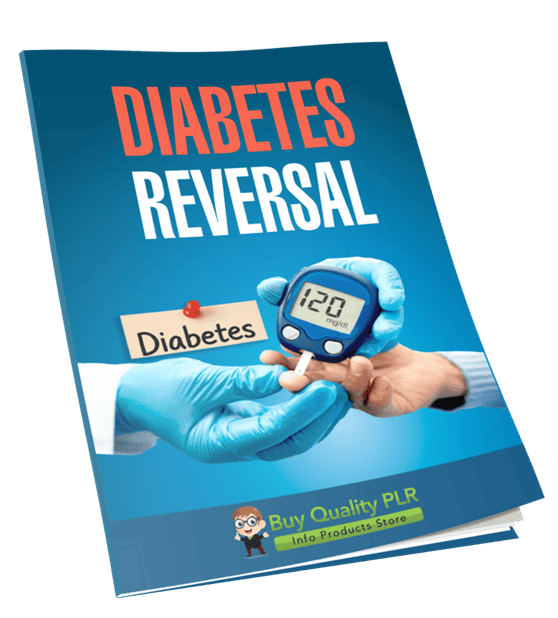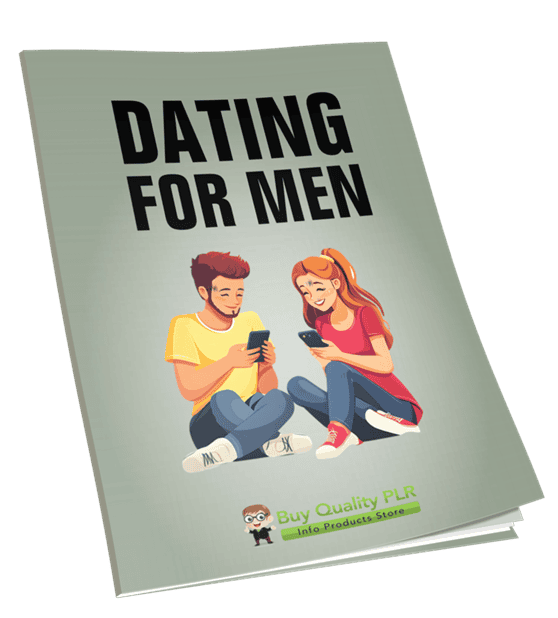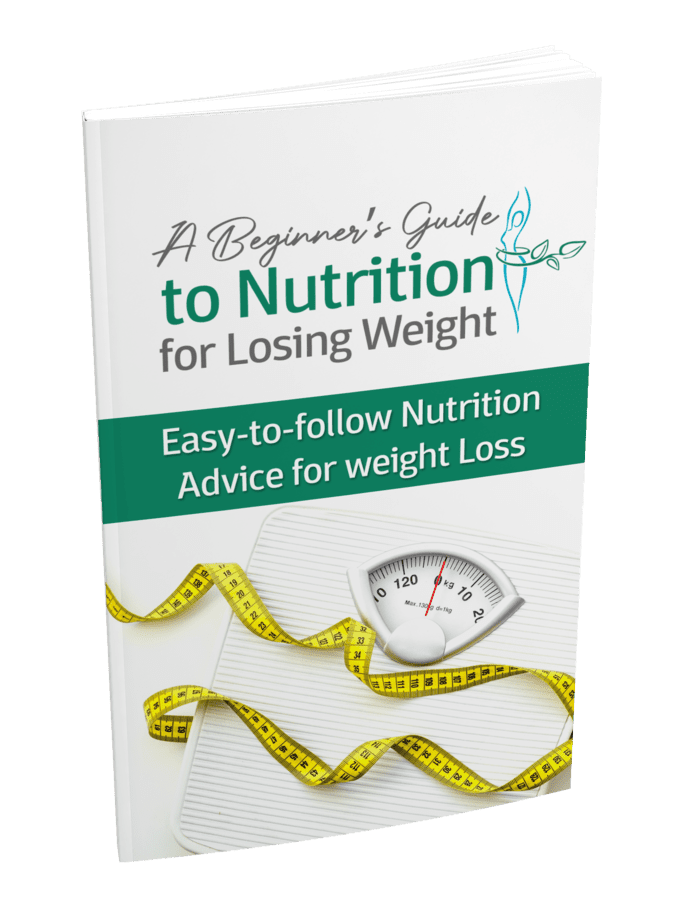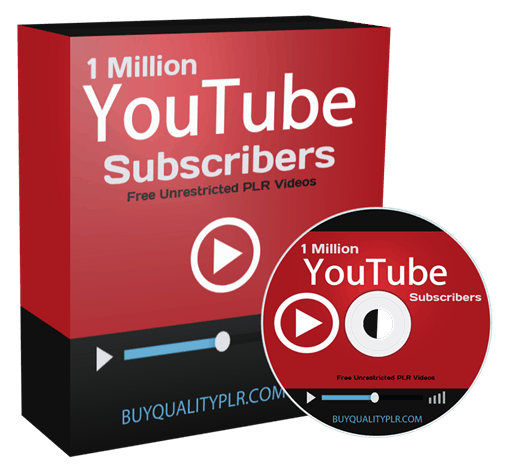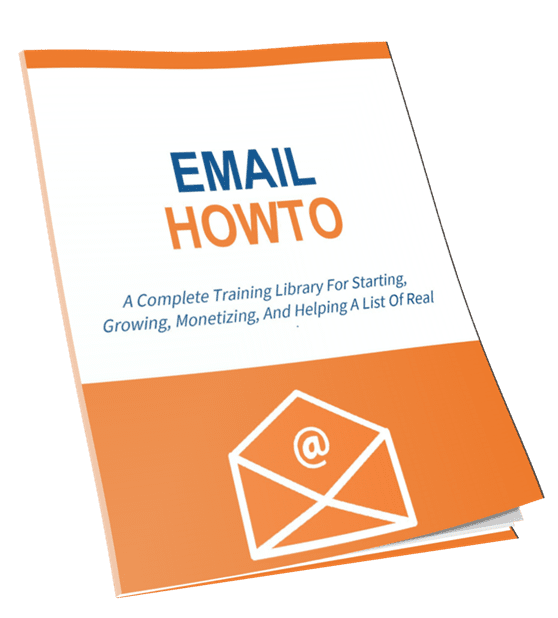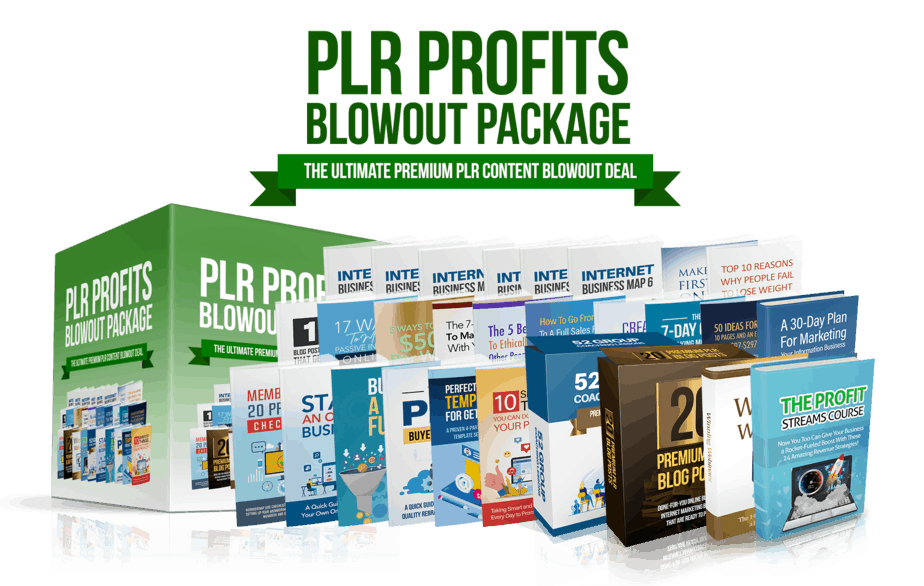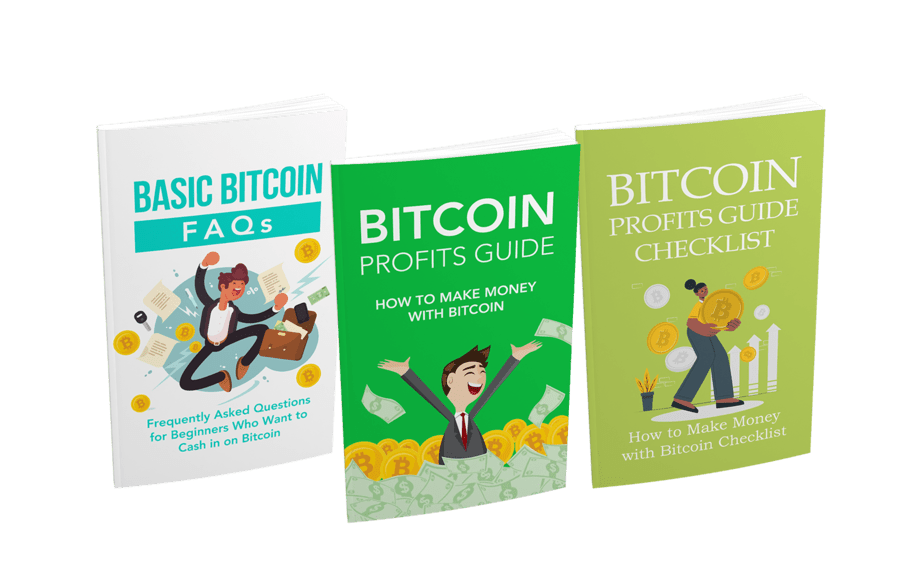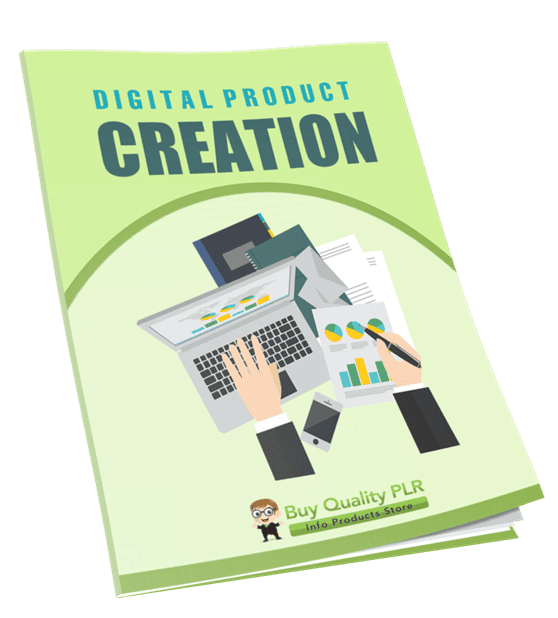
Digital Product Creation PLR Course 21k Words
in Info Product PLR Ebooks , Internet Marketing PLR , Internet Marketing PLR eBooks , Make Money Online PLR Ebooks , Passive Income PLR , PLR Checklists , PLR eBooks , PLR eCourses , PLR List Building Reports , Premium PLR , Premium PLR eBooks , Premium PLR Reports , Premium White Label Brandable PLR Coaching Courses , Private Label Rights ProductsChoose Your Desired Option(s)
has been added to your cart!
have been added to your cart!
#digitalproductcreation #plrcourse #onlinebusiness #passiveincome #infoproductmarketing #monetizeplr #digitalmarketing #createandsell #rebrandplr #workfromhome
Digital Product Creation PLR Course: Your Ultimate Step-by-Step Guide to Creating, Selling, and Profiting from Digital Products
Are you ready to turn your ideas into a profitable online business? With the Digital Product Creation PLR Course, you can teach others how to create and sell their own digital products—whether they’re beginners or seasoned entrepreneurs. This 24,630-word course covers everything from brainstorming product ideas to marketing and scaling your digital product empire. With this comprehensive, easy-to-follow guide, your customers will be equipped to build a successful business through digital products, while you profit from offering the course as your own!
Whether you’re looking to sell this course, create a membership site, or launch a coaching program, the Digital Product Creation PLR Course is a must-have for anyone in the digital business space.
Presenting…
Digital Product Creation PLR Course 21k Words
Course Overview: From Idea to Profits, Step by Step
The Digital Product Creation PLR Course is structured into five detailed modules that will walk your audience through every stage of creating a digital product—from idea generation to marketing and scaling. Each module is designed to be actionable and practical, giving your students the tools they need to succeed.
Module 1: Finding the Right Digital Product Idea
The first step in creating a successful digital product is selecting the right idea. This module helps students identify what they’re passionate about and how to turn it into a profitable digital product.
- Step 1: Understand the Power of Digital Products
- Step 2: Identify Your Strengths & Interests
- Step 3: Research Market Demand & Validate Your Idea
- Step 4: Choose the Right Type of Digital Product
Module 2: Creating High-Quality Digital Products
Once students have their idea, it’s time to create the product! This module covers everything from planning and outlining the product to using the best tools for design and content creation.
- Step 1: Planning & Outlining Your Digital Product
- Step 2: Tools & Software for Product Creation
- Step 3: Designing & Formatting Your Product
- Step 4: Proofreading, Testing & Getting Feedback
Module 3: Packaging & Branding Your Digital Product
Branding and presentation are key to success. In this module, students will learn how to package their products, create compelling covers, and write descriptions that sell.
- Step 1: Creating a Compelling Product Cover & Mockups
- Step 2: Writing a Product Description That Sells
- Step 3: Setting Up a Pricing Strategy
- Step 4: Creating Bonus Offers & Upsells
Module 4: Selling & Delivering Your Digital Product
In this module, students will learn how to sell their product on the right platforms, set up an automated delivery system, and create high-converting sales pages.
- Step 1: Choosing the Right Platform to Sell On
- Step 2: Setting Up an Automated Delivery System
- Step 3: Creating a Sales Page That Converts
- Step 4: Building an Email List for Ongoing Sales
Module 5: Marketing & Scaling Your Digital Product Business
Finally, it’s time to promote and scale. This module covers everything from social media marketing to affiliate partnerships and scaling the business through multiple products.
- Step 1: Promoting Your Product with Social Media & Ads
- Step 2: Leveraging SEO & Blogging to Drive Traffic
- Step 3: Partnering with Affiliates & Influencers
- Step 4: Expanding Your Digital Product Empire
Bonus Materials to Boost Your Profits
In addition to the core course, we’ve included several valuable bonus materials to enhance the learning experience and provide extra value for your customers:
- Digital Product Creation – Checklist (328 words): A simple, easy-to-follow checklist to ensure that students are staying on track throughout the product creation process.
- Digital Product Creation – FAQs (1,057 words): A comprehensive FAQ section answering common questions about digital product creation, selling, and marketing.
- Digital Product Creation – Salespage (574 words): A pre-written sales page that you can use as-is or customize for your own product.
How to Profit from the Digital Product Creation PLR Course
This PLR course provides several opportunities for monetization. Whether you’re looking to sell the course as-is, create additional products around it, or offer coaching services, this course gives you the flexibility to build a profitable business.
1. Sell the Course as a Standalone Product
You can sell this PLR course directly on your website, through third-party platforms like Udemy, Teachable, or Gumroad for $47–$97, depending on your target audience and the value you add.
2. Break the Course into Smaller Reports or Mini-Courses
Break the course into smaller, bite-sized sections and sell them as individual reports or mini-courses for $10-$20 each. This allows you to appeal to a broader audience and increase sales volume.
3. Bundle with Other Digital Products
Bundle the Digital Product Creation PLR Course with other related PLR products, such as marketing guides, business tools, or templates, and sell them as a comprehensive package for $97–$197.
4. Set Up a Membership Site
Offer this PLR course as part of a membership site where subscribers pay monthly fees for access to the course, ongoing resources, and exclusive content. This model generates recurring revenue.
5. Convert Into a Video or Audio Series
Repurpose the course content into a video series or audio lessons to offer a more engaging, multimedia experience for your audience. Sell access to the series for $297-$497.
6. Create Physical Products
Convert the Digital Product Creation course into a physical workbook or guidebook and sell it at a premium price. This works especially well for those who prefer physical resources over digital ones.
7. Use as a Lead Magnet
Offer portions of the course for free in exchange for email sign-ups. This allows you to grow your email list and nurture leads, eventually upselling them to the full course or other products.
What You Can Do with This PLR Course:
Permissions – What Can You Do With These Materials?
- Sell the course as-is with minor tweaks to make it your own.
- Break up the content into smaller reports or mini-courses for $10-$20 each.
- Bundle the course with other related products for $97–$197.
- Set up a membership site and charge recurring fees.
- Convert the course into video lessons, audio series, or physical products.
- Use portions of the course as lead magnets to build your email list.
- Repurpose the content into social media posts, webinars, or eBooks.
Restrictions – What Can’t You Do With These Materials?
- You cannot pass on PLR rights to your customers.
- You cannot offer 100% affiliate commissions.
- You cannot give away the entire course for free; it must be sold or excerpted/modified for giveaways.
- You cannot add the course to existing customer orders without requiring an additional purchase.
Start Creating Profits Today with the Digital Product Creation PLR Course!
The Digital Product Creation PLR Course is your key to unlocking a profitable digital product business. Whether you’re selling the course, building a membership site, or repurposing the content into other formats, this course gives you everything you need to succeed.
Start today and help your audience create digital products while building your own profitable online business!
has been added to your cart!
have been added to your cart!
Here A Sample of Digital Product Creation PLR Course
This course is designed to guide you through the entire process of creating and selling digital products, even if you’re a beginner. From brainstorming your product idea to designing, packaging, and launching it successfully—this course will help you bring your ideas to life!
Module 1: Finding the Right Digital Product Idea
Step 1: Understand the Power of Digital Products
What Are Digital Products?
Digital products are intangible assets that exist in electronic format. Unlike physical products, they do not require inventory, shipping, or manufacturing. Instead, they are created once and can be sold repeatedly without additional production costs.
Some common examples of digital products include:
- Ebooks (guides, how-to manuals, self-help books)
- Online courses (video tutorials, masterclasses, workshops)
- Templates & printables (business templates, planners, worksheets)
- Stock assets (photos, videos, music, sound effects)
- Software & apps (SaaS platforms, mobile applications, website themes)
Digital products can be sold on various platforms, such as personal websites, e-commerce marketplaces (Etsy, Gumroad, Amazon Kindle), and learning platforms (Udemy, Teachable, Thinkific).
Why Are Digital Products a Great Business Opportunity?
The rise of the digital economy has transformed how people consume content and information. More people are turning to online platforms to learn new skills, access valuable resources, and find solutions to their problems. This shift creates a massive demand for digital products, making it a lucrative business opportunity.
Key Reasons Why Digital Products Are an Excellent Business Model:
- Low Initial Investment & High Profit Margins
- Unlike physical businesses that require materials, manufacturing, and shipping, digital products only require time, creativity, and the right tools to develop.
- Once created, they can be sold an unlimited number of times without additional production costs.
- Unlike physical businesses that require materials, manufacturing, and shipping, digital products only require time, creativity, and the right tools to develop.
- Scalability & Passive Income Potential
- Digital products allow you to scale effortlessly. Whether you sell 10 copies or 10,000 copies, the workload remains the same.
- With automation, you can generate sales even while you sleep. Payment processing, product delivery, and customer support can all be set up to run on autopilot.
- Digital products allow you to scale effortlessly. Whether you sell 10 copies or 10,000 copies, the workload remains the same.
- Global Reach & Unlimited Customer Base
- Unlike traditional businesses restricted by geography, digital products can be sold worldwide.
- Buyers from any country can instantly purchase and access your product, expanding your potential market far beyond local boundaries.
- Unlike traditional businesses restricted by geography, digital products can be sold worldwide.
- Diverse Income Streams
- Digital products can be monetized in multiple ways:
- One-time purchases (ebooks, templates)
- Subscription models (memberships, SaaS)
- Licensing fees (stock images, software)
- One-time purchases (ebooks, templates)
- This flexibility allows you to tailor your revenue model based on your target audience and industry.
- Digital products can be monetized in multiple ways:
- Easy to Update & Improve
- Unlike physical products, digital products can be updated at any time.
- If there’s an error in an ebook or a course needs an update, you can simply revise the content and re-upload it without incurring major costs.
- Unlike physical products, digital products can be updated at any time.
- No Shipping, Warehousing, or Logistics
- Since digital products are downloadable or accessible online, they eliminate all the headaches associated with shipping delays, inventory management, and manufacturing defects.
- This means faster delivery, lower costs, and higher customer satisfaction.
- Since digital products are downloadable or accessible online, they eliminate all the headaches associated with shipping delays, inventory management, and manufacturing defects.
- Flexibility & Freedom
- As a digital entrepreneur, you are not tied to a physical location. You can create, manage, and sell digital products from anywhere with an internet connection.
- This business model is ideal for those who want a location-independent lifestyle, allowing for travel, work-life balance, and financial freedom.
- As a digital entrepreneur, you are not tied to a physical location. You can create, manage, and sell digital products from anywhere with an internet connection.
The Future of Digital Products in the Global Market
The demand for digital products continues to grow as consumers look for faster, more accessible solutions to their problems. With increasing internet penetration, mobile device usage, and e-learning adoption, the digital product industry is expected to keep expanding.
If you are looking to build a sustainable, profitable online business, digital product creation is one of the best opportunities available today. The next steps in this course will guide you through the entire process, from choosing the right product idea to launching and selling it successfully.
Step 2: Identify Your Strengths & Interests
Before you create a digital product, you need to find the right topic—one that aligns with your strengths, interests, and expertise. This step is crucial because creating a product takes time and effort. If you choose a subject you are passionate about and skilled in, the process will be more enjoyable, and your product will be more valuable to your audience.
Step 1: Assess What You Are Good At
A. List Your Skills and Expertise
Start by identifying your existing skills, professional experience, and areas of expertise. These can come from your:
- Career background (teaching, finance, marketing, IT, design, etc.)
- Hobbies and personal skills (photography, painting, fitness, music, writing)
- Life experiences (parenting, travel, personal development, overcoming challenges)
Use these guiding questions to help:
- What do people often ask for your advice on?
- What have you studied or worked in professionally?
- What challenges have you overcome that others struggle with?
- What can you do better than the average person?
Write down everything that comes to mind. Even if a skill seems small, it could be valuable as a digital product.
B. Consider Your Teaching Ability
Having expertise is great, but can you explain it in a way that helps others? Teaching is a critical part of digital product creation. Think about:
- Have you ever taught or explained something to someone who found it helpful?
- Are you good at simplifying complex topics?
- Do you enjoy sharing knowledge and helping others improve?
If teaching is not your strength, don’t worry. You can still create digital products like templates, design assets, or tools that don’t require extensive explanations.
Step 2: Discover What You Enjoy
Your digital product should be based on something you enjoy working on. Otherwise, the process may feel like a chore, and you may struggle to stay motivated.
A. Identify Topics You Are Passionate About
Ask yourself:
- What topics do you enjoy learning about?
- If you could work on one topic every day without getting paid, what would it be?
- What activities make you lose track of time?
Your passion will shine through in your product, making it more engaging and authentic. If you enjoy what you create, marketing and selling it will also feel more natural.
B. Find the Intersection Between Skills and Passion
Some topics might interest you, but if you lack expertise, creating a valuable product will be challenging. Conversely, some skills might be profitable, but if you don’t enjoy them, sustaining the business will be difficult.
The ideal digital product idea lies at the intersection of:
- What you’re good at
- What you enjoy
- What people are willing to pay for
Step 3: Turn Your Knowledge, Skills, or Passion Into a Digital Product
Once you have identified your strengths and interests, the next step is transforming them into a marketable digital product. Here’s how:
A. Choose the Right Format for Your Knowledge
Not all knowledge fits into the same type of digital product. Consider these options:
- Ebooks & Guides → Best for step-by-step instructions, insights, and informational content.
- Online Courses → Ideal for structured learning, skills training, and in-depth education.
- Templates & Printables → Great for design skills, productivity tools, or ready-made solutions.
- Membership & Subscription Content → Suitable for ongoing training, coaching, or exclusive community access.
- Software & Digital Tools → Useful for automating tasks, enhancing productivity, or providing solutions.
B. Validate Your Idea with Market Research
Before committing to your digital product idea, check if people are willing to pay for it. You can do this by:
- Searching for similar products on platforms like Amazon Kindle, Udemy, Etsy, or Gumroad.
- Exploring Google Trends to see if your topic is gaining interest.
- Looking at social media and online communities (Reddit, Facebook Groups, Quora) to see what questions people ask.
- Asking your network for feedback on your idea.
If there’s existing competition, that’s a good sign—it means there’s demand. Your goal is to differentiate your product by adding unique value.
C. Start Small and Test Your Idea
If you are unsure about your product’s potential, start with a smaller version before creating a full-scale course or ebook. Some ways to test your idea include:
- Writing blog posts or social media content on the topic to gauge interest.
- Creating a free lead magnet (checklist, mini-guide) to see if people download it.
- Offering a short workshop or webinar to test engagement.
This will help you refine your content and ensure there’s demand before investing more time.
Final Thoughts & Next Steps
By completing this step, you should now have a clear understanding of:
- Your strengths and skills that can be turned into a product.
- Your passions and interests to ensure you enjoy the process.
- How to transform your knowledge into a profitable digital product.
In the next step, we will focus on researching market demand and validating your idea to ensure your product is positioned for success.
Step 3: Research Market Demand & Validate Your Idea
Before investing your time and energy into creating a digital product, you need to ensure that there is actual demand for it. Many course creators and entrepreneurs make the mistake of building a product they are passionate about without first confirming whether people are actively looking for it or willing to pay for it.
In this step, you’ll learn how to:
✔ Use research tools to analyze market trends and customer demand.
✔ Validate your idea before creating the full product.
✔ Ensure your digital product solves a real problem and has a paying audience.
Let’s break this down into a step-by-step process.
Step 1: Research Market Demand Using Online Tools
Market research is the key to understanding what people want, need, and buy. By using data-driven tools, you can determine whether your digital product idea has potential.
A. Google Trends – Check Search Popularity
Google Trends is a free tool that shows how popular a keyword or topic is over time.
- Visit Google Trends.
- Type in a keyword related to your digital product idea (e.g., “online fitness course,” “digital planners,” “graphic design templates”).
- Analyze the trend graph:
- If the interest is rising or stable, it’s a good sign.
- If it’s declining, demand might be decreasing.
- If the interest is rising or stable, it’s a good sign.
- Compare different keywords to see which one is more searched globally or in specific countries.
Example:
If you’re considering a course on “mindfulness meditation,” but Google Trends shows that “stress relief techniques” has a higher and growing interest, you might adjust your focus.
B. Amazon – Check Bestselling Digital Products
Amazon is one of the largest marketplaces for digital products, including ebooks, online courses (through Kindle Direct Publishing), and printables.
- Go to Amazon.com and search for products similar to your idea.
- Look at bestsellers in relevant categories like:
- Kindle eBooks (if you’re writing an ebook)
- Online Learning (if you’re creating a course)
- Workbooks & Templates (if you’re making digital printables)
- Check customer reviews to see:
- What people love about existing products.
- What problems or gaps they mention.
Example:
If you’re planning to create an ebook on “Social Media Marketing,” but you find that customers frequently complain about outdated strategies in existing books, you can position your product as a modern, up-to-date alternative.
C. Etsy – Find Trending Digital Products
Etsy is a global marketplace known for selling digital downloads, including planners, templates, stock photos, and printables.
- Go to Etsy.com and search for your niche (e.g., “wedding planner printable” or “business logo templates”).
- Look at the top-selling products and analyze:
- How many sales they have.
- What their customer reviews mention.
- Their pricing structure.
If a similar digital product has thousands of sales, it proves that demand exists. Your goal is to find a unique angle that makes your product stand out.
Step 2: Validate Your Idea Before Full Commitment
After confirming that demand exists, the next step is validating your idea by testing it in the real world before fully creating the product.
A. Conduct Audience Surveys & Polls
If you already have an audience (email list, social media following, or website visitors), ask them directly:
✔ What are their biggest challenges related to your topic?
✔ Would they pay for a digital product that solves their problem?
✔ What format do they prefer (course, ebook, templates, etc.)?
Tools to use:
- Google Forms (for detailed surveys)
- Instagram & LinkedIn Polls (for quick feedback)
- Facebook Groups & Reddit (ask in niche communities)
If multiple people express interest in the same type of product, it’s a green light!
B. Create a Minimum Viable Product (MVP)
Before building a full-scale course or ebook, test your idea with a simpler version to see how people respond.
Here’s how:
- Offer a free mini-version of your product (e.g., a short guide, checklist, or tutorial).
- Launch a beta version and let a small group test it.
- Pre-sell your product before creating it.
- Example: Offer an online course at a discounted rate for early buyers. If people buy before it’s even made, you have proof of demand!
C. Observe Competitor Engagement
Look at competitor blogs, YouTube videos, and online forums in your niche.
✔ Which posts and videos have the most comments and shares?
✔ What questions are people repeatedly asking?
These clues show what topics people are actively searching for—and what gaps you can fill with your product.
Final Thoughts & Next Steps
By completing this step, you now have:
✔ Data-driven proof that your product idea has demand.
✔ A clear understanding of what your audience wants.
✔ A tested concept that minimizes risk before full development.
Now, you’re ready to move on to Step 4: Plan and Structure Your Digital Product—where you’ll learn how to organize your content and make it engaging and valuable for your audience.
Step 4: Choose the Right Type of Digital Product
Now that you’ve researched and validated your idea, it’s time to choose the best format for your digital product. The format you choose should align with:
✔ Your expertise and strengths.
✔ Your audience’s preferences and learning style.
✔ The ease of creation and market demand.
In this step, you’ll explore different types of digital products and learn how to choose the one that best fits your skills and audience needs.
Step 1: Explore the Different Types of Digital Products
There are many types of digital products you can create. Here’s an overview of the most popular ones:
A. Ebooks – Share Your Knowledge in Written Format
Best for: Writers, educators, experts, and bloggers.
- An ebook is a digital book that can be read on a computer, tablet, or e-reader.
- It is ideal for in-depth topics and step-by-step guides.
- You can sell ebooks on Amazon Kindle, Gumroad, Payhip, or your own website.
Example Topics:
✔ “The Ultimate Guide to Social Media Marketing”
✔ “Healthy Eating for Beginners”
✔ “Mastering Personal Finance”
Pros:
✔ Low cost to create (only requires writing and design).
✔ Can be repurposed into other formats (blog posts, courses, etc.).
✔ Passive income once published.
Cons:
✖ Competitive market—requires strong marketing.
✖ Readers need to be actively engaged in reading.
B. Online Courses – Teach Through Video & Interactive Lessons
Best for: Coaches, trainers, educators, business professionals.
- Online courses allow you to teach a subject through video, slides, and downloadable resources.
- You can host them on platforms like Teachable, Udemy, or Thinkific.
- Courses can be self-paced (students learn at their own speed) or live sessions (interactive learning).
Example Topics:
✔ “How to Start an Online Business”
✔ “Master Adobe Photoshop in 30 Days”
✔ “Public Speaking for Professionals”
Pros:
✔ High perceived value (people are willing to pay more for courses).
✔ Creates long-term authority in your niche.
✔ Can be monetized through subscription models or one-time payments.
Cons:
✖ Requires time to record and edit videos.
✖ Needs a platform to host and manage student access.
C. Templates & Printables – Provide Ready-Made Solutions
Best for: Designers, entrepreneurs, content creators.
- Templates are pre-designed files that users can customize.
- Printables are PDF-based resources that can be used digitally or printed.
- Sell on Etsy, Gumroad, or Creative Market.
Example Products:
✔ Social Media Canva Templates
✔ Resume and Cover Letter Templates
✔ Digital Budget Planners
Pros:
✔ Quick to create once you design a system.
✔ Can sell multiple copies with no extra effort.
✔ Great for passive income.
Cons:
✖ Requires good design skills.
✖ May need updates over time for relevance.
D. Software, Apps, & Plugins – Solve a Specific Problem
Best for: Developers, tech entrepreneurs, problem-solvers.
- Software can be a mobile app, desktop tool, or web application that solves a problem.
- You can sell on your own website, Google Play, or App Store.
Example Products:
✔ Productivity tools (to-do lists, habit trackers)
✔ AI-powered content generators
✔ WordPress plugins
Pros:
✔ High earning potential if solving a real need.
✔ Users stay engaged through updates and new features.
Cons:
✖ Requires coding skills or hiring a developer.
✖ Needs ongoing maintenance and customer support.
E. Stock Photos, Music, & Digital Art – Creative Assets for Sale
Best for: Photographers, musicians, graphic designers.
- Stock content can be sold on platforms like Shutterstock, Adobe Stock, and Pond5.
- Includes photos, illustrations, music tracks, video clips, and fonts.
Example Products:
✔ High-resolution travel photography
✔ Royalty-free background music for videos
✔ Custom fonts and digital calligraphy
Pros:
✔ Can sell to multiple buyers with no extra work.
✔ Passive income—upload once and earn repeatedly.
Cons:
✖ Requires quality and uniqueness to stand out.
✖ Licensing rules need to be well-defined.
Step 2: Decide Which Format is Best for You
Now that you understand different digital products, let’s find the best fit for you.
A. Consider Your Skills & Strengths
Ask yourself:
✔ Do you enjoy writing? → Create an ebook.
✔ Are you good at explaining things? → Make an online course.
✔ Do you have design skills? → Sell templates or printables.
✔ Are you a photographer or musician? → Offer stock content.
B. Identify Your Audience’s Preferences
Different audiences prefer different formats. Consider:
✔ Business professionals → Prefer online courses and templates.
✔ Students & knowledge seekers → Like ebooks and digital workbooks.
✔ Creative professionals → Buy stock photos, fonts, and music.
Use surveys or market research to determine what your audience values most.
C. Choose Based on Ease of Creation
If you’re just starting, choose a format that is easier to create.
✔ Ebooks and templates are quick to produce.
✔ Online courses take more effort but have higher value.
✔ Software requires technical skills or hiring a developer.
Example Decision Path:
If you are a social media marketing expert, you could:
✔ Write an ebook on “Social Media Strategies for Beginners.”
✔ Create a template bundle for Instagram posts.
✔ Develop an online course teaching businesses how to grow online.
Final Thoughts & Next Steps
Now that you’ve chosen your digital product format, it’s time to start creating it!
✔ If you picked an ebook, move on to outlining and writing.
✔ If you chose an online course, start structuring your lessons.
✔ If you decided on templates or printables, begin designing.
Next, we’ll dive into Step 5: Plan and Structure Your Digital Product to ensure your content is engaging, well-organized, and valuable for your audience.
We’re also giving these extra bonuses
Digital Product Creation – Checklist
Digital Product Creation – FAQs

Digital Product Creation – Salespage Content
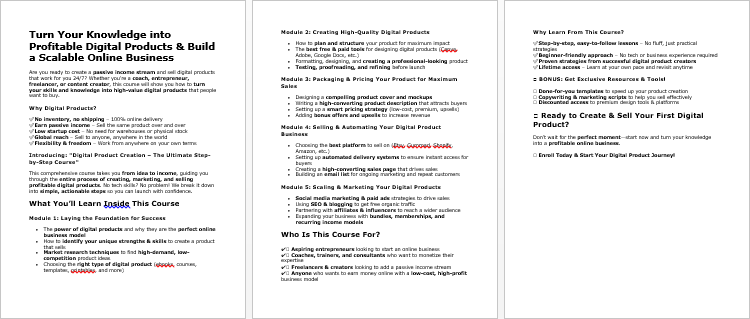
Package Details:
Word Count: 19 630 Words
Number of Pages: 106
Digital Product Creation – Bonus Content
Checklist
Word Count: 626 words
FAQs
Word Count: 1120 words
Salespage Content
Word Count: 928 words
Total Word Count: 21 589 Words
Your PLR License Terms
PERMISSIONS: What Can You Do With These Materials?
Sell the content basically as it is (with some minor tweaks to make it “yours”).
If you are going to claim copyright to anything created with this content, then you must substantially change at 75% of the content to distinguish yourself from other licensees.
Break up the content into small portions to sell as individual reports for $10-$20 each.
Bundle the content with other existing content to create larger products for $47-$97 each.
Setup your own membership site with the content and generate monthly residual payments!
Take the content and convert it into a multiple-week “eclass” that you charge $297-$497 to access!
Use the content to create a “physical” product that you sell for premium prices!
Convert it to audios, videos, membership site content and more.
Excerpt and / or edit portions of the content to give away for free as blog posts, reports, etc. to use as lead magnets, incentives and more!
Create your own original product from it, set it up at a site and “flip” the site for megabucks!
RESTRICTIONS: What Can’t You Do With These Materials?
To protect the value of these products, you may not pass on the rights to your customers. This means that your customers may not have PLR rights or reprint / resell rights passed on to them.
You may not pass on any kind of licensing (PLR, reprint / resell, etc.) to ANY offer created from ANY PORTION OF this content that would allow additional people to sell or give away any portion of the content contained in this package.
You may not offer 100% commission to affiliates selling your version / copy of this product. The maximum affiliate commission you may pay out for offers created that include parts of this content is 75%.
You are not permitted to give the complete materials away in their current state for free – they must be sold. They must be excerpted and / or edited to be given away, unless otherwise noted. Example: You ARE permitted to excerpt portions of content for blog posts, lead magnets, etc.
You may not add this content to any part of an existing customer order that would not require them to make an additional purchase. (IE You cannot add it to a package, membership site, etc. that customers have ALREADY paid for.)
Share Now!

